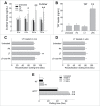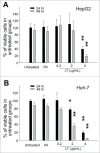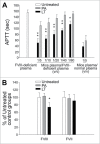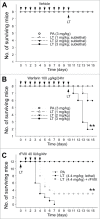Acquired coagulant factor VIII deficiency induced by Bacillus anthracis lethal toxin in mice
- PMID: 25906166
- PMCID: PMC4601479
- DOI: 10.1080/21505594.2015.1031454
Acquired coagulant factor VIII deficiency induced by Bacillus anthracis lethal toxin in mice
Abstract
Mice treated with anthrax lethal toxin (LT) exhibit hemorrhage caused by unknown mechanisms. Moreover, LT treatment in mice induced liver damage. In this study, we hypothesized that a suppressed coagulation function may be associated with liver damage, because the liver is the major producing source of coagulation factors. The hepatic expression of coagulant factors and the survival rates were analyzed after cultured cells or mice were exposed to LT. In agreement with our hypothesis, LT induces cytotoxicity against hepatic cells in vitro. In addition, suppressed expression of coagulation factor VIII (FVIII) in the liver is associated with a prolonged plasma clotting time in LT-treated mice, suggesting a suppressive role of LT in coagulation. Accordingly, we further hypothesized that a loss-of-function approach involving treatments of an anticoagulant should exacerbate LT-induced abnormalities, whereas a gain-of-function approach involving injections of recombinant FVIII to complement the coagulation deficiency should ameliorate the pathogenesis. As expected, a sublethal dose of LT caused mortality in the mice that were non-lethally pretreated with an anticoagulant (warfarin). By contrast, treatments of recombinant FVIII reduced the mortality from a lethal dose of LT in mice. Our results indicated that LT-induced deficiency of FVIII is involved in LT-mediated pathogenesis. Using recombinant FVIII to correct the coagulant defect may enable developing a new strategy to treat anthrax.
Keywords: Anthrax; coagulation factor VIII; hemorrhage; lethal toxin.
Figures






Similar articles
-
Soluble P-selectin rescues mice from anthrax lethal toxin-induced mortality through PSGL-1 pathway-mediated correction of hemostasis.Virulence. 2017 Oct 3;8(7):1216-1228. doi: 10.1080/21505594.2017.1282027. Epub 2017 Jan 19. Virulence. 2017. PMID: 28102766 Free PMC article.
-
Activated protein C ameliorates Bacillus anthracis lethal toxin-induced lethal pathogenesis in rats.J Biomed Sci. 2012 Nov 21;19(1):98. doi: 10.1186/1423-0127-19-98. J Biomed Sci. 2012. PMID: 23170801 Free PMC article.
-
Bacillus anthracis genomic DNA enhances lethal toxin-induced cytotoxicity through TNF-α production.BMC Microbiol. 2014 Dec 4;14:300. doi: 10.1186/s12866-014-0300-9. BMC Microbiol. 2014. PMID: 25472474 Free PMC article.
-
New insights into the functions of anthrax toxin.Expert Rev Mol Med. 2006 Apr 11;8(7):1-18. doi: 10.1017/S1462399406010714. Expert Rev Mol Med. 2006. PMID: 16608555 Review.
-
The roles of anthrax toxin in pathogenesis.Curr Opin Microbiol. 2004 Feb;7(1):19-24. doi: 10.1016/j.mib.2003.12.001. Curr Opin Microbiol. 2004. PMID: 15036135 Review.
Cited by
-
Targeted Delivery to Dying Cells Through P-Selectin-PSGL-1 Axis: A Promising Strategy for Enhanced Drug Efficacy in Liver Injury Models.Cells. 2024 Oct 27;13(21):1778. doi: 10.3390/cells13211778. Cells. 2024. PMID: 39513885 Free PMC article.
-
Soluble P-selectin rescues viper venom-induced mortality through anti-inflammatory properties and PSGL-1 pathway-mediated correction of hemostasis.Sci Rep. 2016 Oct 25;6:35868. doi: 10.1038/srep35868. Sci Rep. 2016. PMID: 27779216 Free PMC article.
-
Soluble P-selectin rescues mice from anthrax lethal toxin-induced mortality through PSGL-1 pathway-mediated correction of hemostasis.Virulence. 2017 Oct 3;8(7):1216-1228. doi: 10.1080/21505594.2017.1282027. Epub 2017 Jan 19. Virulence. 2017. PMID: 28102766 Free PMC article.
-
Suppressive effect of dengue virus envelope protein domain III on megakaryopoiesis.Virulence. 2017 Nov 17;8(8):1719-1731. doi: 10.1080/21505594.2017.1343769. Epub 2017 Jul 20. Virulence. 2017. PMID: 28622093 Free PMC article.
-
Exposure of Platelets to Dengue Virus and Envelope Protein Domain III Induces Nlrp3 Inflammasome-Dependent Platelet Cell Death and Thrombocytopenia in Mice.Front Immunol. 2021 Apr 29;12:616394. doi: 10.3389/fimmu.2021.616394. eCollection 2021. Front Immunol. 2021. PMID: 33995345 Free PMC article.
References
-
- Dixon TC, Meselson M, Guillemin J, Hanna PC. Anthrax. N Engl J Med 1999; 341:815-26; PMID:10477781; http://dx.doi.org/10.1056/NEJM199909093411107 - DOI - PubMed
-
- Collier RJ, Young JA. Anthrax toxin. Annu Rev Cell Dev Biol 2003; 19:45-70; PMID:14570563; http://dx.doi.org/10.1146/annurev.cellbio.19.111301.140655 - DOI - PubMed
-
- Moayeri M, Leppla SH. The roles of anthrax toxin in pathogenesis. Curr Opin Microbiol 2004; 7:19-24; PMID:15036135; http://dx.doi.org/10.1016/j.mib.2003.12.001 - DOI - PubMed
-
- Kau JH, Shih YL, Lien TS, Lee CC, Huang HH, Lin HC, Sun DS, Chang HH. Activated protein C ameliorates Bacillus anthracis lethal toxin-induced lethal pathogenesis in rats. J Biomed Sci 2012; 19:98; PMID:23170801; http://dx.doi.org/10.1186/1423-0127-19-98 - DOI - PMC - PubMed
-
- Kau JH, Sun DS, Huang HH, Wong MS, Lin HC, Chang HH. Role of visible light-activated photocatalyst on the reduction of anthrax spore-induced mortality in mice. PloS One 2009; 4:e4167; PMID:19132100; http://dx.doi.org/10.1371/journal.pone.0004167 - DOI - PMC - PubMed
Publication types
MeSH terms
Substances
Supplementary concepts
LinkOut - more resources
Full Text Sources
Other Literature Sources
Medical
Research Materials
